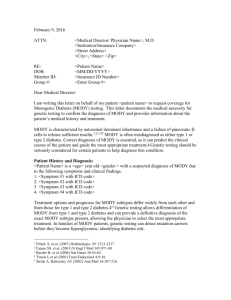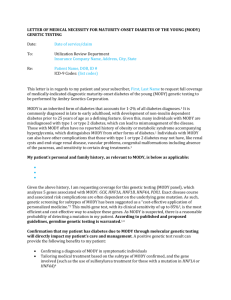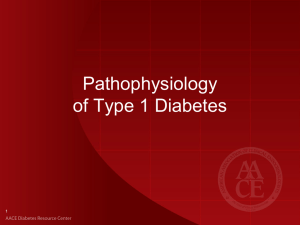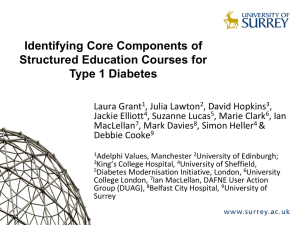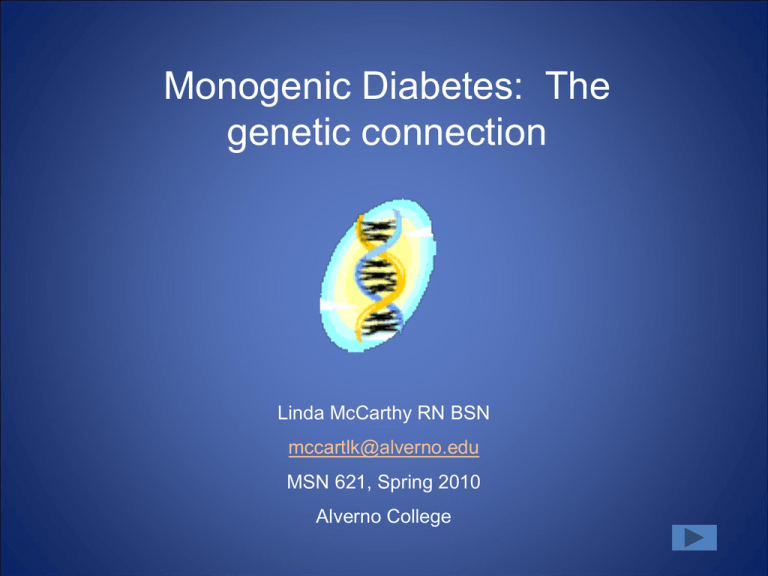
Monogenic Diabetes: The
genetic connection
Linda McCarthy RN BSN
mccartlk@alverno.edu
MSN 621, Spring 2010
Alverno College
Tutorial Directions
• Click on
to go to previous slide.
• Click on
to go to next slide or section.
• Click on
to go back to home page.
• Click on or hover over the underlined words for explanation.
http://www.free-clipart-pictures.net/school_clipart.html
Objectives of tutorial
• After completing this tutorial the learner will have a better
understanding of Monogenic Diabetes and be able to
recognize the presenting symptoms and pattern of
inheritance of monogenic diabetes. They will understand the
difference between type 1, type 2 and Monogenic Diabetes.
• Topics included:
– Signs / symptoms.
– Genetic inheritance and pathogenesis
– Genetic Testing / Genetic Counseling
– Management / treatment
Image retrieved from Microsoft clipart, 2007
Review of Diabetes Classification
• I. Type 1 diabetes:
characterized by
destruction of the
pancreatic beta cells
• An absolute lack of insulin,
an elevation in blood
glucose and a breakdown of
fats and proteins.
• Prone to develop diabetic
ketoacidosis (DKA)
Porth & Matfin, 2009
Image retrieved with permission from: http://en.wikipedia.org/wiki/Diabetes
Diabetes Classifications, continued
• II. Type 2 diabetes:
• Insulin deficiency
• Impaired ability of the tissues to
use insulin (insulin resistance)
and / or impaired release of
insulin caused by beta cell
dysfunction.
• Accounts for about 90- 95% of
diabetes cases.
Retrieved with permission from: http://whatisdiabetes.us/type2diabetes052309.jpg
Porth & Matfin, 2009
III. Gestational Diabetes
• Any degree of glucose
intolerance with onset
or first recognition
during pregnancy.
• Caused by a
combination of insulin
resistance and impaired
insulin secretion.
•
Porth & Matfin, 2009
Image retrieved with permission from
http://www.healthsystem.virginia.edu/internet/diabetes/description.cfm
IV. Other types of Diabetes
1. Diseases of exocrine pancreas, for example
pancreatitis, neoplasm, cystic fibrosis.
2. Endocrine disorders such as acromegaly &
Cushing syndrome.
3. Infections such as congenital rubella &
cytomegalovirus.
4. Genetic defects in beta cell function, for
example, glucokinase. MODY is in this category.
•
Porth & Matfin, 2009
Criteria for the diagnosis of diabetes mellitus
• 1. A1C >6.5%. OR
• 2. Fasting Plasma Glucose 126 mg/dl (7.0 mmol/l). Fasting is
defined as no caloric intake for at least 8 hours. OR
• 3. Two-hour plasma glucose 200 mg/dl (11.1 mmol/l) during
an OGTT. OR
• 4. In a patient with classic symptoms of hyperglycemia or
hyperglycemic crisis, a random plasma glucose 200 mg/dl
(11.1 mmol/l).
• *In the absence of unequivocal hyperglycemia, criteria 1–3
should be confirmed by repeat testing.
American Diabetes Association. (2010) Standards of Medical Care in Diabetes
Let’s Review
Type 1 Diabetes is the result of?
a. Insulin resistance due to impaired ability of the
tissues to use insulin.
No, this is type 2 diabetes
b. Absolute lack of Insulin due to loss of beta cell
function.
Yes, type 1 DM is the result of beta cell destruction
c. Genetic condition in which the beta cells do not
make enough insulin.
No, this is MODY
Which type of diabetes is
most common?
Type 1
No, try again
Type 2
Correct,
accts for 9095%
MODY
No, try again
Gestational Diabetes
No, try again
How is Diabetes Diagnosed?
(Click on letter below for correct answer)
a. 2 Separate Fasting Plasma Glucose levels
greater than or equal to126 mg/dl.
b. Symptoms of fatigue, polydypsia
and polyuria
No, try again
c. A single A1C level of greater than
or equal to 6.5%
No, try again
d. A Finger stick > 126.
Clipart, 2007
No, try again
Correct, Diabetes is diagnosed by 2 fasting blood sugar levels
over 126 or 2 A1C levels greater than or equal to 6.5%. It is not
diagnosed based on symptoms alone.
Great job!
DM is caused by a lack of:
(Click on letter below for correct answer)
a.
gluconeogenesis
b.
glucagon
c.
insulin
d.
Free Fatty Acids
No, try again
No, try again
Correct!
No, try again
Clipart, 2007
Which of the following is not a symptom
of diabetes
(Click on letter below for correct answer)
a.
polydipsia
b.
polyuria
No, try again
No, try again
Clipart, 2007
c.
d.
Water retention
polyphagia
Correct!
No, try again
Insulin is a hormone produced by what
cells?
(Click on letter below for correct answer)
a.
neutrophils
No, try again
b.
Red blood cells
c.
beta cells
Correct!
d.
T- cells
No, try again
No, try again
Clipart, 2007
Let’s review Insulin Signaling Pathways
Click the link below for a
review of Normal Insulin
secretion
http://vcell.ndsu.edu/animations/insulinsign
aling/movie-flash.htm
Animation used with permission Dr Phil McClean, NDSU, April, 2010
Case Study: Monogenic diabetes
Autosomal
Dominant
Inheritance:
Family with 4
children. Dad & 2
of the 4 children
have MODY.
Clipart, 2007
Diagnosis: father, 1991
• Diagnosed at age 29. Thin
body habitus.
• No symptoms in childhood.
Did notice wt loss in college,
attributed to exercise. 1
sibling with pre-diabetes.
• Grandparents on both sides
had “old age onset” diabetes.
• Treatment: initially diet /
exercise, then sulfonylurea,
now Lantus / humalog. No
genetic testing done.
Clip art, 2007
Diagnosis: oldest son, 2004
•
•
•
•
Clip Art, 2007
Age 18.
Thin, athletic, runner.
No apparent symptoms
Treatment: initially diet
/ exercise, added
glimiperide, and Lantus.
No genetic testing was
done.
Diagnosis: youngest daughter, 2007
Clip Art, 2007
• Age: 12 in 6th grade.
• Blood sugar at home:
>350 and initial A1c =
8.5
• treated as type 1 with
Novolog and Lantus
• Genetic testing in 2009
confirmed HNF4
(MODY1).
What is MODY?
Maturity-onset diabetes of the young (MODY) is a group of
genetic disorders that cause diabetes. At this time, 6 different
subtypes of MODY have been identified.
first recognized in 1974-1975 by Tattersall (Tattersall, R.B.
1974).
MODY is called Monogenic diabetes and has an autosomal
dominant mode of inheritance.
In some cases, the gene mutation is inherited; but in others,
the gene mutation develops spontaneously.
Nyunt, et al, 2009
Prevalence
of MODY
Clipart, 2007
Exact prevalence not known, estimated to be
responsible for 2-5% of cases of non-insulin
dependent diabetes. MODY prevalence is
underestimated and it is sometimes
misdiagnosed as type 2.
Nyunt, et al, 2009
Clinical Features to help differentiate Type
1, Type 2, and MODY
Type 1 DM
Type 2 DM
MODY
Frequency
Common
Increasing
2 – 5% of non insulin dependent
Diabetics
Genetics
Polygenic
Polygenic
Monogenic
Autosomal
Dominant
Family History
<15%
>50%
100%
Ethnicity
Different races
Asians, Polynesians,
Indigenous
Australians
Different races
Age of onset
Throughout
Childhood
Post-Puberty
<25 yrs
Nyunt, et. al 2009
Clinical Features to help differentiate Type
1, Type 2, and MODY, continued
TYPE 1
TYPE 2
MODY
Severity of onset
Acute and severe
Mild
Mild/Asymptomatic
Ketosis / DKA
Common
Uncommon
Rare
Obesity
+/−
>90%
+/−
Acanthosis
Nigricans
Absent
Common
Absent
Metabolic
Syndrome
Absent
Common
Absent
Auto-immunity
Positive
Negative
Negative
Pathophysiology
β Cell destruction
Insulin resistance
and relative
insulinopaenia
β Cell dysfunction
Nyunt, et. al 2009
Acanthosis Nigricans
http://fromyourdoctor.com/topic.do?title=Acanthosis+Nigricans&
t=6015
• a skin disorder
characterized by
hyperpigmentation and
"velvety" thickening of the
skin, particularly of skin fold
regions.
• It is associated with insulin
resistance. Acanthosis
nigricans will improve or
resolve with treatment of
the underlying disorder.
Porth, & Matfin, 2009
http://www.nytimes.com/imagepages/2007/08/01/health/adam/2353Acantho
sisnigricansonthehand.html
a. Weight loss, acetone breath, Diabetic Ketoacidosis.
No, this is type 1 diabetes
b. Weight gain , insulin resistance, metabolic syndrome.
No, this is type 2 diabetes
c. Usually discovered during pregnancy.
No, this is gestational diabets
d. Abnormal Beta cell function, often presents in youth,
although may not be recognized until early adulthood.
Correct, MODY has autosomal dominant inheritance with
abnormal function of beta cells. Hyperglycemia is mild to moderate
and can often be treated with oral medication.
Great job!
Pathophysiology of Monogenic
Diabetes
• Caused by mutations
in nuclear
transcription factors
and glucokinase
genes which result in
Beta cell dysfunction
in the production of
insulin.
Used with
permission:http://www.bodyclinicindonesia.com/library/beta_cell.jpg
Nyunt, et. al , 2009
Insulin Production by Pancreatic Beta Cell
1.
2.
3.
4.
5.
Glucose enters cell
Glycolysis makes ATP
ATP production
causes K+ channel to
close and depolarize
the cell
Depolarization
opens voltage
sensitive Ca2+
channels (Ca2+
enters cell)
Ca2+ influx causes
insulin release.
Image used with permission, Dr Nyunt 3/2010
.
Inflammation and Insulin Resistance
• Obesity is associated with
chronic low-level
inflammation.
• Insulin resistance is the
condition in which a normal
amount of insulin is
inadequate to produce a
normal response from fat,
muscle and liver cells. This
leads to elevated blood
glucose
(Porth & Matfin, 2009)
Central obesity
http://healthhabits.files.wordpress.com/2008/05/type-2diabeetus.jpg (image modified)
Inflammation and Diabetes
Studies suggest that, “insulin
resistance or increased body
weight, rather than glycemia or
impaired beta cell function,
contributes to the
proinflammatory state in
prediabetic individuals.”
Elevation of CRP (C-reactive
protein) or PAI-1 (plasminogen
activator inhibitor) should be
considered predictors of
diabetes.
Festa, et al, 2003
http://www.natap.org/2006/IntCo/011806/fatDerived-1.gif
Effects of Aging & Diabetes
• Aging is accompanied by 2–4-fold increase in
inflammatory mediators such as cytokines.
Many factors contribute to this low-grade
inflammation, including an increased amount
of fat tissue, decreased production of sex
steroids, smoking, infections and chronic
disorders such as cardiovascular diseases and
Alzheimer’s disease. Evidence suggests that
aging is associated with a dysregulated
cytokine response. Several inflammatory
mediators such as tumor necrosis factor-a and
interleukin-6 have the potential to induce or
aggravate risk factors in age-associated
pathology.
Krabbe, et al, 2004
Clipart, 2007
Stress and Diabetes, what’s the
relationship?
• Stress causes a fight or
flight response. The
neuroendocrine and
immune systems
respond.
• Catecholamine and
coritsol are released to
provide increased
alertness.
•
Porth & Matfin, 2009
Image Retrieved from www.mindbodypsychotherapy.net/mbconnection.htm
Stress, continued
• Stress hormones that are designed to deal with
short-term danger can stay turned on for a long time.
• Ability to adapt is determined by many factors: age,
health status, nutrition, hardiness and others.
• During the stress response, glucose is released from
the liver, muscles and stored fat. This causes an
elevation in blood glucose. Chronic stress can cause
a long term elevation in blood glucose. Porth & Matfin, 2009
Which of these can cause the blood
glucose to rise?
Insulin
resistance
Cortisol
insulin
yes!
no
glucagon
laughter
Yes!
no
Dietary
indiscretion
yes
stress
yes
infection
yes
exercise
Usually no.
yes!
MODY subtypes
MODY
Subtypes
Clinical Features
MODY 1:
HNF4A
Hepatic Nuclear Transcription Factor 4A gene. Transient
hyperinsulinemic Hypoglycemia, familial hyperlipidemia, increased
sensitivity to sulfonylurea. Uncommon
MODY 2:
GCK
Glucokinase Gene. Mild insulin deficiency, Low birth weight infants
(unaffected mothers), Neonatal Diabetes Mellitus in homozygous.
common.
MODY 3:
HNF1A
Hepatic Nuclear Factor F1A gene. Similar to features of HNF4A.
Pancreatic exocrine failure, Increased sensitivity to sulfonylureas,
glycosuria. Most common
Used with permission Nyunt, et. al 2009, (modified)
MODY subtypes, cont.
MODY Subtypes
Clinical Features
MODY 4: IPF1
insulin promotor factor 1
Pancreatic agenesis
MODY 5: HNF1B
Hepatic nuclear factor 1B
Congenital anomalies of urinary tract,
Agenesis of pancreatic tail and body,
Pancreatic exocrine failure
MODY 6: NeuroD1
Neurogenic differentiation 1
Pancreatic anomalies
OTHER MODY subtypes:
-KLF11. Krueppel-like factor 11
Pancreatic malignancy
-CEL gene (controls both exocrine and
endocrine function in the pancreas)
Pancreatic exocrine and endocrine
failure
-PAX4
Paried box gene 4
Diabetes mellitus
Nyunt, et. al 2009
Monogenic Diabetes
What is the most common subtype of MODY?
(click on box for answer)
MODY 3 which has a mutation in the Hepatic
Nuclear Factor F1A gene
How many classes of MODY are there?
3
4
5
7
Yes, 6 subtypes of MODY
6
Can you identify the genes responsible
for MODY?
HNF4A
HNF1A
IPF1
MODY 1
MODY 3
MODY 4
LOL
SOL
Ha ha!
Hope not…
HNF1B
MODY 5
NEUROD1
MODY 6
GCK
MODY 2
IAA
no, Insulin
Autoantibodies
Autosomal Dominant Inheritance
What is the chance of
this couple’s children
inheriting MODY?
Click on this text for answer.
The affected child will have a
50% chance of passing
MODY onto their children.
http://www.diabetes.niddk.nih.gov/dm/pubs/mody/#3
Key Characteristics of MODY:
•
•
•
•
Presentation is non-ketotic hyperglycemia
Lack of auto antibodies
Age of onset < 25 years
Click
to learn
the Keydiabetes,
Characteristics
Non
insulin
dependent
defined by
treatment without insulin for 5 years, or
measurable C-peptide.
• Can be mistaken for type 1 or type 2.
Algorithm for investigation of hyperglycaemia. DM- Diabetes
Mellitus, LADA- Latent Autoimmune Diabetes in Adults, CFRDCystic Fibrosis Related Diabetes Mellitus, AD- Autosomal
Dominant Inheritance.
Nyunt, o, et. al 2009
Why is Monogenic Diabetes difficult to
recognize?
• Unfamiliarity with importance of family history.
• Healthcare professionals’ lack of confidence
regarding genetics and other autosomal dominant
conditions.
• Technical language involved in genetics is confusing
for some healthcare providers.
• Small patient population. Diabetic Nurse Educator
said she had seen 1 case in 14 years of practice.
Shepherd, 2001
Treatment
• Depends on which type MODY, some can be
treated with diet and exercise.
• Most will need pharmacological treatment
due to progressive deterioration in glycemic
control.
• Patients with MODY are extremely sensitive to
Sulfonylurea which have shown to be 4 times
as effective in lowering glucose than
metformin. (Hattersly, et al, 2009)
Treatment of MODY, continued
- Some can be maintained on Sulfonylurea
for many decades and glycemic control is
often better than that achieved on insulin.
- Initial dose is low, ¼ the normal starting
dose.
(Hattersly, et al, 2009)
Image retrieved from: Microsoft Word Clipart 2003
Sulfonylureas work well in treating MODY
• Drugs such as Glipizide, Glyburide and Glimiperide.
• Mechanism: Stimulate insulin secretion by closing
Click to learn the mechanism of action of Sulfonylureas
the Beta cell’s K+ channel causing depolarization and
calcium influx.
• Side Effects:
–
–
–
–
Hypoglycemia
Rashes
GI upset
Hyponatremia
Treatment of MODY, continued
- MODY subtypes HNF1A and HNF4A:
approximately 1/3 will require insulin due to
progressive beta cell dysfunction. (Nyunt, et al, 2009)
Image retrieved with permission from: http://www.endotext.org/Diabetes/diabetes20/figures/figure7.png
Genetic Testing can be Life Changing
• Lilly, diagnosed with type 1
diabetes @ 11months
• On insulin pump for years
• Saliva DNA test done
• + genetic mutation
• Admitted to hospital and
weaned off insulin pump
• Now on oral medication
http://www.monogenicdiabetes.org/jaffe_story.html
Genetic Testing & Counseling
• Positive Implication for treatment: switch to
oral agent once mutation is identified!
• Treatment geared to specific mutation.
• Cost of test: not covered by insurance: $1700
• Implications for off spring due to dominant
inheritance; 50% chance of passing this on.
Nursing outcomes
• Knowledge: Diabetes Management
• Provide education re: disease presentation
and genetic component. This may involve
teaching our colleagues due to unfamiliarity of
this disease.
• Teach self care techniques re: medication,
diet, exercise.
• Provide genetic testing information.
Iowa Outcomes project, (2000)
a. Mild and usually treated with oral medication
Yes
b. Requires genetic testing to determine subtype
Yes
c. Presents over the age of 50.
No, usually presents < 25 yrs old
d. Accounts for 15% of all type 2 diabetes.
No, MODY is rare and only accounts for 2-5% of type 2
MODY: SUMMARY
•
•
•
•
Mild diabetes at presentation
Strong family history
Age of onset usually before age 25
Features inconsistent with other types of
diabetes: No significant obesity or acanthosis
• Sensitivity to Sulfonylurea and may require
insulin later in life.
Congratulations
you have completed
the Monogenic
Diabetes Tutorial!
References, Monogenic Diabetes
•
•
•
•
•
•
•
•
•
American Diabetes Association, Standards of medical care in Ddabetes—2010, Diabetes Care, Volume 33,
supplement 1, January 2010 S11-s25.
Festa A, Hanley AJ, Tracy RP, D'Agostino, R , & Haffner, S. (2003 ). Inflammation in the prediabetic state is
related to increased insulin resistance rather than decreased insulin secretion. Circulation, 108:1822-1830.
Hattersly A., Bruining, J., Sheild, J., Njolstad, p., & Donaghue, K. (2009) The diagnosis and management of
monogenic diabetes I children and adolescents. Pediatric Diabetes, 10 (suppl 12), 33-42.
Iowa Outcomes project, (2000) Nursing Outcomes Classification (NOC) (2nd ed.). St. Louis, Missouri:
Mosby, Inc.
Krabbe, K.S., Pedersen, M., Bruunsgaard, H. (2004). Inflammatory mediators in the elderly. Experimental
Gerontology, (39) 687-699.
Nyunt, o., y, J., McGown, I., Harris, M., Huynh, T., Leong, G., Cowley, D., Cotterill, A., (2009). Investigating
Maturity onset diabetes of the young. Clin Biochem Rev. 2009 May; 30(2): 67–74.
Porth, C.M & Matfin, G. (2009) Pathophysiology: Concepts of Altered Health States. Philadelphia:
Lippincott Williams & Wilkins.
Shepherd, M., Stride, A., Ellard, S., & Hattersley, A. (2003). Integrating genetics into diabetes care: a new
role for DSNs. Journal of Diabetes Nursing, 7(8), 289-292.
Tattersall, R.B., Mild familial diabetes with dominant inheritance. QJ Med 1974/ 43: 339-57. (this
reference was taken from the Nyunt, Ohn et all article. Reference #1. )
THANK YOU to those who helped!
• My husband Joe, for his patience and willingness to be a guinea pig and
tester.
• My children because I was “absent from home this semester”
• Pat Bowne for her wisdom and help in learning the “tutorial way.” (along
with everything else!)
• My mother, by her example of hard work, encouraged me to pursue my
Master’s Degree.


